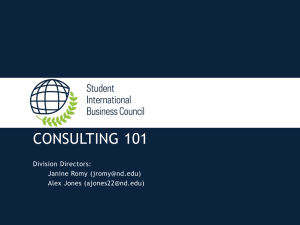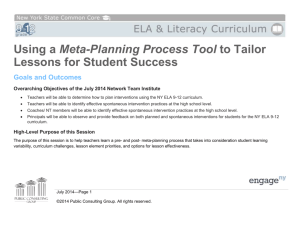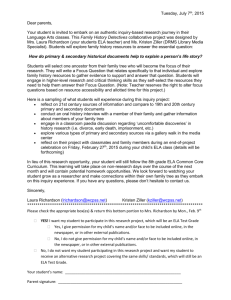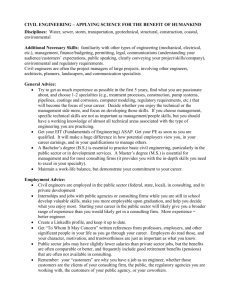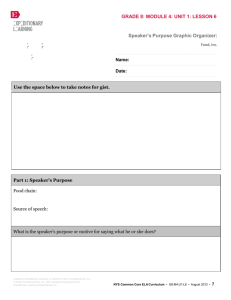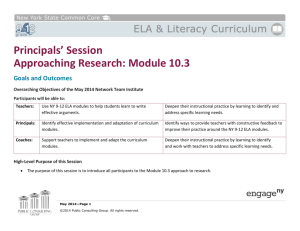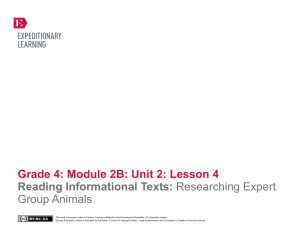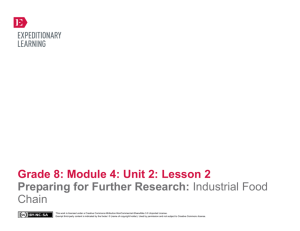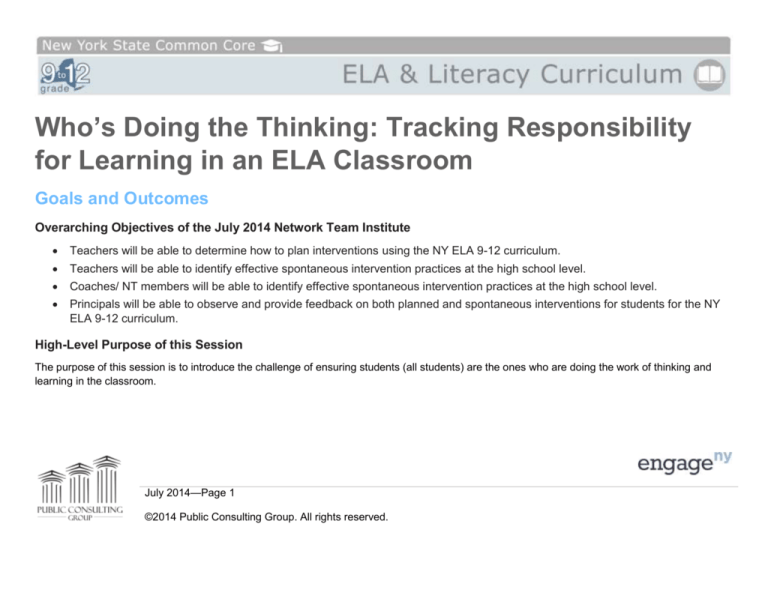
Who’s Doing the Thinking: Tracking Responsibility
for Learning in an ELA Classroom
Goals and Outcomes
Overarching Objectives of the July 2014 Network Team Institute
Teachers will be able to determine how to plan interventions using the NY ELA 9-12 curriculum.
Teachers will be able to identify effective spontaneous intervention practices at the high school level.
Coaches/ NT members will be able to identify effective spontaneous intervention practices at the high school level.
Principals will be able to observe and provide feedback on both planned and spontaneous interventions for students for the NY
ELA 9-12 curriculum.
High-Level Purpose of this Session
The purpose of this session is to introduce the challenge of ensuring students (all students) are the ones who are doing the work of thinking and
learning in the classroom.
July 2014—Page 1
©2014 Public Consulting Group. All rights reserved.
New York State Common Core
Related Learning Experiences
Scaffolding Background Knowledge for ELLs
Using a Meta-Planning Process Tool to Tailor Lessons for Student Success
Key Points
In order to ensure that all students are learning, it is imperative first to ensure that all students are thinking critically, as much as possible, as
often as possible.
Teachers influence who is doing the thinking in a classroom by culture setting, careful planning, and working the room effectively in the
moment.
Session Outcomes
What do we want participants to be able to do as a result of this session?
How will we know that they are able to do this?
Identify shifts in the responsibility for learning in an ELA classroom.
In-session discussion
Explain what does, and does not, constitute evidence of student thinking.
Aligned survey question
July 2014—Page 2
©2014 Public Consulting Group. All rights reserved.
New York State Common Core
Session Overview
Section
Time
Overview
Introduction
5 min
Participants learn the purpose and
objectives for this session.
Analysis of Instruction:
Video
Reflection and Closing
45 min
Prepared Resources
Session PowerPoint
Facilitator Preparation
Download and review all
session materials.
Identify and review video
of instruction
Participants watch a video of HS
ELA classroom instruction and
analyze whether the teacher or the
students are doing the thinking at
different points in the video.
Session PowerPoint
Cue up video.
Video of instruction
Who’s Thinking Now Note
Catcher
Position mic runners at
various spots around the
room for report out.
Processing “Who’s Doing
the Thinking” Activity Sheet
5 min
Participants reflect on their
learning in this session.
Session PowerPoint
Position mic runners at
various spots around the
room for report out.
55 mins
Total for this session
July 2014—Page 3
©2014 Public Consulting Group. All rights reserved.
New York State Common Core
Session Roadmap
Section: Introduction
In this section, you will learn the purpose and objectives for this
session.
Materials used include: Session PowerPoint
Slide Time
Script/Activity Directions
1
Picture
2 min
Welcome participants to this session.
July 2014—Page 4
©2014 Public Consulting Group. All rights reserved.
New York State Common Core
Slide Time
2
Total
time:
Picture
Script/Activity Directions
Briefly review the purpose of the session and the session objectives,
written on the slide. At the end of this session, participants should be able
to:
3 min
5 min
July 2014—Page 5
©2014 Public Consulting Group. All rights reserved.
Identify shifts in the responsibility for learning in an ELA classroom.
Explain what evidence of student thinking is, and isn’t.
New York State Common Core
Section: Analysis of Instruction: Video
In this section, you will watch a video of HS ELA classroom
instruction and analyze whether the teacher or the students are
doing the thinking at different points in the video.
Slide
Time
3
20 min
Picture
Materials used include: Sesssion PowerPoint, Video of instruction, Who’s
Thinking Now Note Catcher, Processing “Who’s Thinking Now” Activity Sheet.
Script/Activity Directions
Explain the upcoming activity to participants. Tell them they will see a short
video excerpt from a classroom. They will watch the video once completely
through to understand what is happening. Then, they will watch it again and
use the Who’s Thinking Now Note Catcher in their material packet to track
whether it is the teacher or the students who are doing the most thinking at a
given moment in the video.
Ask participants to watch the video. Play the video once, without stopping.
Ask participants to briefly discuss with a partner what they saw happening in
the video.
Ask participants to turn to the Who’s Thinking Now Note Catcher in their
materials. Instruct participants to watch the video again. Tell them that, this
time, you will stop the video at regular intervals and give the participants 60
seconds to capture 1) who is doing the bulk of the thinking in that moment and
2) why they think this is so.
Play the video a second time, stopping at regular intervals. (The intervals may
depend on available time for this activity or natural breaks in the lesson. Note:
July 2014—Page 6
©2014 Public Consulting Group. All rights reserved.
New York State Common Core
Slide
Time
Picture
Script/Activity Directions
the most powerful videos will come from your own site and your own teachers.)
Once participants have watched the video a second time, play it a third time
without stopping and ask participants to check their responses. Do they stand
by their selections?
4
Ask participants to turn to the Processing “Who’s Doing the Thinking” sheet in
their materials packets. Ask each table group to select a facilitator. Then, ask
the groups to discuss each question using the following protocol:
25 min
1 minute: Group members write their response to the question silently.
3 minutes: Group members discuss their responses
Once groups have discussed each of the questions, invite participants to share
some of their observations. These will vary widely, but should demonstrate an
awareness of some of the following ideas:
Total
time:
It is very difficult for a teacher working the room in the moment to keep
students doing the thinking much of the time.
It is easy to default to giving an answer and asking students to find
evidence for that answer.
Talking does not equal thinking. Thinking is more visible in the types of
talking—the processing, the analysis, not the connection making as
much or the “me too” statements. We need to go for the deep thinking.
45
mins
July 2014—Page 7
©2014 Public Consulting Group. All rights reserved.
New York State Common Core
Section: Reflection and Closing
In this section, you will reflect on the learning in this session.
Materials used include: Session PowerPoint
Slide
Time
Script/Activity Directions
5
5 min
Picture
Ask participants to discuss the questions on the slide and tweet one takeaway
with #NTIny
What does it look like when a student is doing the work of thinking and
learning in a HS ELA classroom?
What do you need to do more of to ensure this is happening? Less of?
Differently?
July 2014—Page 8
©2014 Public Consulting Group. All rights reserved.
New York State Common Core
Slide
Time
Picture
6
Script/Activity Directions
Give participants the chance to ask questions.
Total
time:
5
mins
Turnkey Materials Provided
Session PowerPoint
Video of Instruction
Who’s Thinking Now Note Catcher
Processing “Who’s Doing the Thinking” Activity Sheet
July 2014—Page 9
©2014 Public Consulting Group. All rights reserved.
New York State Common Core
Video: Carthage High School, Jennifer Hanno, Grade 10, available at: https://www.youtube.com/watch?v=LjGnEAsqsnI
July 2014—Page 10
©2014 Public Consulting Group. All rights reserved.


